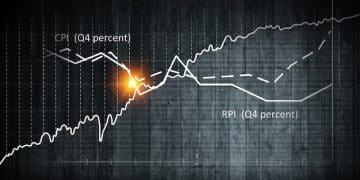US Treasury Yields Surge: What It Means for Investors

The recent surge in US Treasury yields signals shifting economic expectations, directly impacting loan rates, bond valuations, and investor strategies across various asset classes, necessitating a reevaluation of portfolio allocations.
In the dynamic world of finance, every market movement sends ripples. The recent surge in US Treasury yields has certainly caught the attention of investors and analysts alike. But beyond the headlines, what does this significant shift truly signify for your investments, from everyday savings to long-term portfolio planning?
Understanding the Yield Surge: The Basics
The concept of Treasury yields might seem complex, but at its core, it reflects the return an investor receives on US government debt. When yields surge, it means the perceived risk or opportunity cost of holding that government debt has increased. This movement is not isolated; it intertwines with broader economic indicators and investor sentiment, reflecting a collective outlook on inflation, economic growth, and monetary policy.
What are Treasury Yields?
Treasury yields are essentially the interest rates the US government pays to borrow money from investors. These yields are seen as a benchmark for many other interest rates in the economy because US Treasury bonds are considered among the safest investments globally. Different maturities, from short-term bills to long-term bonds, have their own yields, forming what is known as the yield curve.
- Bills: Mature in less than one year.
- Notes: Mature in 1 to 10 years.
- Bonds: Mature in more than 10 years, typically 20 or 30 years.
- Real Yields: Yields adjusted for inflation, providing a clearer picture of returns.
The recent surge has been particularly pronounced across various maturities, suggesting a broad recalibration by the market regarding future economic landscapes. This isn’t just a technical adjustment; it’s a fundamental signal about expected economic conditions.
Drivers Behind the Current Surge
Several factors contribute to the recent upward trajectory in Treasury yields. Foremost among them is the persistent inflation narrative, which suggests that the Federal Reserve might need to maintain higher interest rates for longer than previously anticipated. This hawkish stance aims to curb inflationary pressures, but it also makes fixed-income assets, like bonds, less attractive if their fixed payments are eroded by rising prices.
Additionally, stronger-than-expected economic data, particularly in areas like employment and consumer spending, indicates economic resilience. While positive for growth, a robust economy can also fuel inflationary concerns, prompting investors to demand higher yields to compensate for potential purchasing power erosion over time. This dynamic interplay between growth, inflation, and monetary policy expectations creates a complex environment for bond markets, pushing yields higher as investors reassess their risk and return profiles.
Furthermore, increased government borrowing, often to fund fiscal stimulus or address budget deficits, can also put upward pressure on yields. When the supply of new bonds increases, and demand does not keep pace, prices fall, and yields rise. Geopolitical events and global capital flows also play a subtle but significant role, influencing investor appetite for safe-haven assets and thus impacting Treasury demand.
The recent surge is a multifaceted phenomenon, reflecting a culmination of these economic forces and market expectations. For investors, understanding these underlying drivers is crucial for interpreting the implications and adjusting strategies accordingly.

Immediate Impacts on Investment Portfolios
A significant shift in Treasury yields doesn’t happen in a vacuum; its effects cascade across virtually all asset classes, from equities and real estate to other fixed-income instruments. Investors must understand these immediate repercussions to proactively manage their portfolios and mitigate potential risks.
Bonds and Fixed Income
The most direct impact of surging Treasury yields is on the value of existing bonds. When new bonds are issued at higher yields, older bonds with lower yields become less attractive, causing their market prices to fall. This inverse relationship between bond yields and prices is fundamental to fixed-income investing. Investors holding long-duration bonds are particularly vulnerable to these price declines, as their fixed payments become less valuable relative to new, higher-yielding issues.
- Price Depreciation: Existing bond values decrease when new bond yields rise.
- Yield-to-Maturity Changes: Higher current yields mean new bonds offer better returns if held to maturity.
- Reinvestment Risk: Investors may face lower yields when reinvesting proceeds from maturing bonds if yields eventually fall.
- Duration Sensitivity: Longer-duration bonds are more sensitive to yield changes.
For those looking to invest in fixed income, higher yields present an opportunity to lock in better returns. However, for those already holding bonds, especially those with longer maturities, the current environment means navigating potential capital losses. Diversification within fixed income, considering shorter-duration assets or inflation-protected securities, can help buffer some of these impacts.
Equities and Growth Stocks
The equity market, especially the growth-oriented segments, also feels the pinch when Treasury yields surge. Growth stocks, which derive a significant portion of their valuation from future earnings expectations, are particularly sensitive to rising interest rates. This is because higher discount rates (often tied to Treasury yields) are used to calculate the present value of those future earnings. When discount rates rise, the present value of distant earnings falls, thereby reducing the intrinsic value of these companies.
Beyond valuation concerns, higher borrowing costs can also squeeze corporate profits, especially for companies with significant debt loads. This can temper investment, slow expansion, and ultimately impact earnings growth, which is a key driver of stock prices. While the impact might be more pronounced on growth stocks, the broader equity market can also experience headwinds as the cost of capital generally rises.
However, some sectors may fare better. Financial stocks, for example, often benefit from a steeper yield curve, which can improve their net interest margins. Value stocks, which are typically less reliant on distant future earnings, might also hold up relatively better in a rising yield environment. This highlights the importance of sector rotation and strategic allocation within the equity component of a portfolio.
The current environment pushes investors to reassess their exposure to different equity styles and sectors, favoring those with strong balance sheets and less sensitivity to interest rate fluctuations. It also reinforces the adage that not all stocks perform equally in all market conditions.
Broader Economic Implications
The ripple effect of surging Treasury yields extends far beyond investment portfolios, touching various facets of the broader economy. These shifts influence everything from consumer borrowing costs to corporate investment decisions, collectively shaping the economic landscape.
Mortgage Rates and Consumer Loans
Perhaps one of the most tangible impacts for the average consumer is on borrowing costs. Mortgage rates, auto loans, and other forms of consumer credit are often benchmarked against Treasury yields. As yields rise, lenders typically adjust their rates upward to maintain profitability, making borrowing more expensive for individuals and families.
This can significantly dampen demand in interest-sensitive sectors like housing. Higher mortgage rates mean a less affordable housing market, potentially slowing down new home sales and construction. For existing homeowners, rising rates can make refinancing less appealing, impacting decisions on home improvements or debt consolidation. Similarly, elevated auto loan rates can affect new car purchases, filtering down to the automotive industry.
For consumers with variable-rate debt, the impact is even more immediate, as their monthly payments could increase, squeezing household budgets. Understanding this direct link is crucial for individuals making significant purchasing or borrowing decisions in a rising interest rate environment.
Corporate Borrowing and Investment
Businesses, much like consumers, are sensitive to the cost of capital. When Treasury yields surge, corporate borrowing costs typically follow suit, making it more expensive for companies to issue new debt or refinance existing obligations. This can impact investment decisions, especially for capital-intensive industries or companies reliant on external financing for growth.
Higher interest expenses can erode corporate profits, potentially leading companies to scale back expansion plans, delay new projects, or reevaluate their capital allocation strategies. Smaller businesses, which often have less access to diverse financing options, might be particularly vulnerable to increased borrowing costs, potentially hindering their growth and job creation efforts.
Conversely, companies with strong cash flows and less reliance on debt may find themselves in a more advantageous position, having greater flexibility to weather the rising rate environment. This dynamic can lead to a divergence in corporate performance, favoring fiscally sound entities over highly leveraged ones. The overall effect could be a moderation of corporate investment across the economy, influencing industrial output and long-term economic growth potential.
The interplay of these factors means that a surge in Treasury yields is not just a financial market event but a genuine economic catalyst, influencing activity from the ground up.
What Does This Mean for Different Investor Profiles?
The implications of surging Treasury yields vary significantly depending on an investor’s age, risk tolerance, investment horizon, and existing portfolio allocation. Understanding how these factors interact with the current market environment is key to making informed decisions.
Retirees and Income-Focused Investors
For retirees and those primarily focused on generating income from their investments, rising Treasury yields can present a mixed bag of challenges and opportunities. On one hand, the principal value of existing bonds held in their portfolios may decline, leading to capital losses if those bonds are sold before maturity. This can be concerning for individuals nearing or in retirement who rely on stable portfolio values.
On the other hand, higher new bond yields mean that fresh capital, whether from maturing bonds, reinvested income, or new contributions, can be invested at more attractive rates. This enables income-focused investors to potentially secure higher streams of passive income over time. For those with a relatively short investment horizon, or those who need to access their capital soon, the focus shifts to minimizing capital depreciation while seeking opportunities for enhanced income through new fixed-income purchases.
Strategies for this group might include:
- Laddering bonds: Spreading maturities to ensure regular cash flow and opportunities to reinvest at higher rates.
- Considering short-duration funds: Less susceptible to interest rate fluctuations.
- Exploring dividend stocks: For diversified income sources, though with higher risk than bonds.
- Reviewing annuity options: For guaranteed income streams, especially if rates improve terms.
The key is balancing the desire for income stability with the reality of market fluctuations, adapting to new opportunities as they arise.
Growth-Oriented and Younger Investors
Younger investors, often with longer investment horizons and a greater tolerance for risk, might see surging Treasury yields through a different lens. While growth stocks may face near-term headwinds due to higher discount rates, the long-term outlook for equities remains largely tied to corporate earnings growth and innovation. The current volatility might even present buying opportunities for certain high-quality growth companies at more attractive valuations.
For these investors, the focus remains on long-term capital appreciation. While a portion of their portfolio might be in fixed income for diversification, the predominant strategy will likely involve equities. The rising yield environment may prompt a reevaluation of sector overweights, perhaps shifting some allocation from highly rate-sensitive tech stocks to more value-oriented cyclicals or defensive sectors that are less impacted by interest rate fluctuations in the short term.
Furthermore, a longer horizon allows for patience. Market corrections driven by rising interest rates are often temporary, and staying invested through periods of volatility is often a prerequisite for capturing long-term equity returns. This group might also consider diversifying into alternatives or international markets, where different economic cycles and interest rate regimes could offer uncorrelated returns.
The primary concern for younger investors should be ensuring that their asset allocation remains aligned with their long-term goals and risk capacity, leveraging the time advantage to ride out market cycles. This means maintaining a strategic asset allocation while being opportunistic with tactical adjustments.
Strategies for Navigating the Current Environment
In a period of surging Treasury yields, proactive portfolio management becomes paramount. Investors have several strategies at their disposal to mitigate risks and potentially capture new opportunities, adapting their portfolios to the evolving economic landscape.
Diversification and Asset Allocation
The timeless principle of diversification gains renewed importance in times of market volatility driven by rising rates. A well-diversified portfolio spreads risk across various asset classes, reducing the impact of underperformance in any single area. This means looking beyond traditional equities and fixed income to include real estate, commodities, or even alternative investments, depending on an investor’s risk profile and access.
Within fixed income, diversifying by maturity can be beneficial. A “barbell” strategy, holding both short-term and long-term bonds while avoiding the intermediate maturities, can allow investors to benefit from higher short-term rates without being overly exposed to the price sensitivity of mid-duration bonds. Rebalancing the portfolio periodically, adjusting asset allocations back to target levels, helps ensure alignment with long-term financial goals and risk tolerance.
For instance, if equities have performed strongly as yields rise, resulting in an overweight position, rebalancing might involve selling some equities and reallocating to new, higher-yielding fixed-income instruments. This systematic approach helps in taking profits and redeploying capital strategically.
Considering Inflation-Protected Securities (TIPS)
As a direct response to inflation concerns which often drive yields higher, Treasury Inflation-Protected Securities (TIPS) become particularly attractive. Unlike conventional Treasury bonds, the principal value of TIPS adjusts with changes in the Consumer Price Index (CPI), offering a hedge against inflation. This means that as inflation rises, the par value of the TIPS increases, and so do the interest payments, protecting the investor’s purchasing power.
TIPS can provide a valuable component to a fixed-income portfolio, especially for investors concerned about the erosion of purchasing power over time. While their yields might be lower than nominal Treasuries during periods of high inflation expectations, their inflation-linked principal offers a unique safeguard. Investors should understand that TIPS still carry interest rate risk, meaning their market price can fluctuate with real interest rates (nominal rates minus inflation).
Therefore, TIPS should be considered as part of a broader fixed-income strategy, providing a defensive play against inflation while still being subject to market forces. Integrating them judiciously can enhance portfolio resilience.
Reviewing Debt and Cash Positions
In a rising interest rate environment, revisiting personal and corporate debt structures is a critical strategy. For individuals, this means scrutinizing variable-rate loans, such as certain mortgages or credit card debt, which can become more expensive as rates climb. Prioritizing the repayment of high-interest, variable debt can lead to significant savings. Conversely, fixed-rate debt, if acquired at lower rates, becomes more attractive as new rates rise.
For companies, this involves assessing capital structure, refinancing opportunities, and the potential impact of higher borrowing costs on profitability and growth plans. Deleveraging or locking in fixed rates can provide stability in an uncertain rate environment. On the cash front, rising yields also mean better returns on savings accounts, money market funds, and short-term certificates of deposit (CDs). Rather than letting cash sit idle in low-yield accounts, investors can now find more attractive returns, albeit still moderate, potentially offsetting some of the inflationary pressures on their liquidity.
This allows for more strategic cash management, ensuring that even liquid assets are working harder. The overarching theme is to minimize the drag of higher interest payments while maximizing the benefit from higher interest income on cash and new bond investments.
Future Outlook and Long-Term Implications
Predicting the precise trajectory of Treasury yields is notoriously difficult, as it hinges on a complex interplay of economic indicators, monetary policy decisions, and geopolitical events. However, understanding the potential long-term implications of elevated yields can help investors position themselves strategically for the future.
Potential Scenarios for Yield Movement
Several scenarios could unfold for Treasury yields in the coming months and years. One possibility is that yields stabilize or even decline if inflation moderates more rapidly than expected and the Federal Reserve begins to signal a shift towards a more dovish monetary policy. This would likely be driven by clearer signs of economic cooling or a disinflationary trend.
Alternatively, yields could continue their upward trajectory if inflation proves to be more persistent, economic growth remains robust, or government borrowing demands intensify. Such a scenario would imply a sustained period of higher interest rates, impacting all aspects of the economy from corporate investment to consumer spending. A third scenario involves continued volatility, where yields fluctuate significantly based on incoming economic data and central bank commentary, creating a challenging environment for fixed-income investors but also potential trading opportunities.
The market also closely watches the shape of the yield curve, which can signal investor expectations for future economic growth and recessions. An inverted yield curve, where short-term yields are higher than long-term yields, has historically preceded economic downturns. While the current curve might not be fully inverted across all maturities, its flattening or inversion in key segments is a critical indicator to monitor.
Adapting Long-Term Investment Strategies
Regardless of the short-term fluctuations, the recent surge in yields underscores the importance of dynamic and adaptable long-term investment strategies. For many years, a low-yield environment pushed investors into riskier assets in search of returns. Now, with higher yields becoming a reality, fixed income once again offers a more compelling proposition, potentially allowing for greater diversification and lower overall portfolio risk without sacrificing too much return.
This shift encourages a reevaluation of traditional 60/40 (60% equities, 40% bonds) portfolios, where the bond component can now offer more meaningful income and potentially better diversification benefits against equity market downturns. Investors with long horizons should consider dollar-cost averaging, investing a fixed amount regularly, which helps smooth out the effects of market volatility and takes advantage of potential dips.
Furthermore, the long-term outlook emphasizes the importance of quality in both equity and fixed-income holdings. Companies with strong balance sheets, consistent earnings, and competitive advantages are better positioned to weather periods of higher interest rates. Similarly, sovereign and corporate bonds from issuers with strong credit profiles tend to offer greater stability. International diversification can also play a role, as global interest rate cycles and economic conditions may not perfectly align with those in the US, offering additional avenues for return and risk mitigation.
Ultimately, the long-term implications suggest a return to an environment where fixed income offers more genuine yield, potentially rebalancing the risk-reward equation across asset classes. This calls for a patient, disciplined, and forward-looking approach to portfolio construction, focusing on resilience and adapting to evolving market dynamics rather than reacting to every headline.
| Key Point | Brief Description |
|---|---|
| 📈 Yield-Price Inversión | Higher yields mean lower existing bond prices. |
| 🏘️ Mortgage Impact | Rising yields lead to higher mortgage and loan rates. |
| 💰 Investor Opportunity | New bond purchases offer better income returns. |
| 🛡️ Diversification Key | Spreading investments across assets mitigates risks. |
Frequently Asked Questions About Treasury Yields
▼
US Treasury yields surge primarily due to rising inflation expectations, strong economic data indicating robust growth, and an increased supply of government debt. The Federal Reserve’s hawkish stance on monetary policy, anticipating higher interest rates for longer, also contributes to this upward pressure. Global financial conditions and investor demand for safe assets play a role as well.
▼
A surge in Treasury yields can negatively impact the stock market, especially growth stocks. Higher yields increase the discount rate used to value future earnings, reducing present valuations. Additionally, rising borrowing costs can squeeze corporate profits, making equities less attractive relative to now higher-yielding safe bonds. Some sectors like financials may benefit from steeper yield curves.
▼
For savers, higher Treasury yields are generally good, as they translate into better returns on savings accounts, money market funds, and new fixed-income investments like CDs and bonds. This means that cash held in interest-bearing accounts can earn more. However, existing bondholders may experience a decline in the principal value of their current holdings if they sell before maturity.
▼
Rising Treasury yields typically lead to higher mortgage rates and other consumer loan rates. This makes borrowing more expensive, potentially dampening consumer demand for housing and automobiles. Higher mortgage rates reduce housing affordability, which can slow down home sales, decrease property values, and impact the overall real estate market, affecting both buyers and sellers.
▼
Investors can employ several strategies: diversify portfolios across asset classes (equities, fixed income, alternatives); consider inflation-protected securities (TIPS) as a hedge; shorten bond durations or use a barbell strategy; review and potentially refinance variable-rate debt; and seek opportunities in sectors that benefit from rising rates, like financials. Rebalancing regularly helps maintain target asset allocations.
Conclusion
The recent surge in US Treasury yields is more than just a financial headline; it is a profound signal of shifting economic tides that demands careful consideration from investors across all profiles. These movements reflect evolving expectations regarding inflation, economic growth, and the future path of monetary policy, cascading effects throughout the financial ecosystem. From the direct impact on bond valuations and corporate borrowing costs to the indirect influence on mortgage rates and consumer spending, understanding this dynamic is crucial for informed decision-making. While the short-term implications can present challenges, they also create opportunities—particularly for those with new capital or a flexible investment strategy. Ultimately, adapting portfolios through diversification, strategic asset allocation, and a keen eye on economic fundamentals remains paramount. The current yield environment reinforces the importance of a patient and disciplined approach, positioning investors for resilience in an ever-evolving market.





